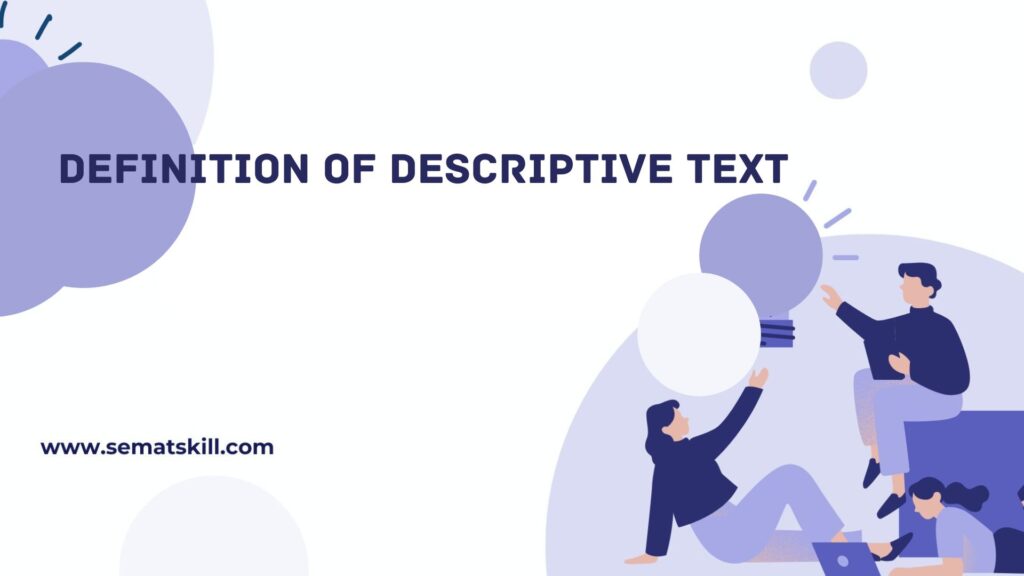Descriptive text is a form of writing used to describe a person, place, object, or event in detail. The primary goal of descriptive text is to create a vivid picture in the reader’s mind using sensory details and descriptive language. This type of writing helps the reader visualize and experience the subject by appealing to their senses: sight, sound, smell, taste, and touch.

Components of Descriptive Text
Introduction (Pendahuluan) The introduction provides an overview of the subject being described. It sets the scene for the detailed description that follows and often includes the main idea or purpose of the description.
- Example:
“The ancient library nestled at the end of Elm Street is a hidden gem. With its grand architecture and historical charm, it stands as a testament to a bygone era, inviting visitors into a world of knowledge and tranquility.” - Penjelasan: Pendahuluan memberikan gambaran umum tentang subjek yang akan dijelaskan. Ini mengatur konteks dan menarik minat pembaca untuk mengeksplorasi deskripsi lebih lanjut.
Body (Isi) The body of the text is where the detailed description takes place. This section should include specific details and sensory descriptions that help the reader visualize and experience the subject. Organizing the description logically, such as by spatial or chronological order, enhances clarity.

- Example:
“Upon entering the library, visitors are greeted by the rich aroma of aged paper and polished wood. The high, vaulted ceilings are supported by intricately carved wooden beams, and the soft light from the antique chandeliers casts a warm glow over the room. Shelves lined with leather-bound books stretch from floor to ceiling, their spines decorated with gold lettering. The gentle rustle of pages and the quiet footsteps of fellow readers contribute to a serene atmosphere that invites quiet reflection and exploration.” - Penjelasan: Bagian ini menyajikan deskripsi rinci dari subjek, menggunakan detail yang spesifik dan deskripsi sensorik untuk membantu pembaca membayangkan dan mengalami subjek secara mendalam.
Conclusion (Kesimpulan) The conclusion summarizes the description and may offer a final reflection on the subject. It often encapsulates the overall impression or significance of the subject, leaving the reader with a lasting thought.
- Example:
“In essence, the ancient library is more than just a place of books; it is a sanctuary for those seeking knowledge and solace. Its timeless beauty and serene environment continue to captivate visitors, offering a peaceful retreat from the hustle and bustle of modern life.” - Penjelasan: Kesimpulan merangkum deskripsi dan memberikan pemikiran akhir tentang subjek. Ini memberikan penutup yang memuaskan dan mengesankan bagi pembaca.
Examples of Descriptive Text
Describing a Place (Deskripsi Tempat)
- Example:
“The botanical garden is a paradise of vibrant colors and fragrances. As you stroll through the winding paths, you’re enveloped by the sweet scent of blooming flowers and the chirping of birds. Exotic plants and towering trees create a lush canopy overhead, their leaves rustling softly in the breeze. The garden’s tranquil pond reflects the sky and surrounding flora, adding to the peaceful ambiance.” - Penjelasan: Deskripsi tempat ini menonjolkan warna, aroma, dan suasana untuk menciptakan gambaran yang jelas dan memikat dalam pikiran pembaca.
Describing a Person (Deskripsi Orang)
- Example:
“John is a man of striking presence. His tall, athletic build and confident stride make him stand out in a crowd. His deep blue eyes sparkle with intelligence and curiosity, while his warm smile exudes friendliness and approachability. He often dresses in smart, casual attire that complements his charismatic personality. John’s engaging conversations and genuine interest in others make him a memorable and well-liked individual.” - Penjelasan: Deskripsi orang ini mencakup penampilan fisik dan sifat pribadi dengan detail yang memungkinkan pembaca membayangkan dan memahami karakter individu tersebut.
Describing an Object (Deskripsi Objek)
- Example:
“The antique clock is a masterpiece of craftsmanship. Its ornate wooden frame, with intricate carvings and a polished finish, highlights the skill of its maker. The clock face features elegant Roman numerals and delicate gold hands that sweep smoothly across its surface. The rhythmic ticking sound and occasional chime add a nostalgic touch, making it not just a timepiece but a cherished heirloom.” - Penjelasan: Deskripsi objek ini memberikan detail tentang desain, bahan, dan fungsi, menciptakan gambaran yang hidup dan menarik tentang benda tersebut.
Tips for Writing Effective Descriptive Text
Use Sensory Details (Gunakan Detail Sensorik) Incorporate descriptions that appeal to the senses—sight, sound, smell, taste, and touch. Sensory details help create a more vivid and immersive experience for the reader.
- Penjelasan: Detail sensorik membuat deskripsi lebih hidup, memungkinkan pembaca untuk mengalami subjek seolah-olah mereka berada di sana.
Be Specific (Jelas dan Spesifik) Provide specific details rather than general statements. The more precise your descriptions, the more vivid the image in the reader’s mind.
- Penjelasan: Detail yang spesifik membantu pembaca membayangkan subjek dengan lebih jelas dan akurat, meningkatkan kualitas deskripsi.
Organize Logically (Organisasi yang Logis) Arrange your descriptions in a logical order, such as spatial order (left to right, top to bottom) or chronological order (from beginning to end). This helps maintain clarity and coherence in your text.
- Penjelasan: Mengatur deskripsi secara logis membantu pembaca mengikuti alur teks dengan mudah dan memahami informasi dengan lebih baik.
Use Figurative Language (Gunakan Bahasa Kiasan) Enhance your descriptions with figurative language such as metaphors, similes, and personification to add depth and creativity.
- Penjelasan: Bahasa kiasan menambah dimensi dan keindahan dalam deskripsi, membuat teks lebih menarik dan memikat.
Revise and Edit (Revisi dan Edit) Review your descriptive text for clarity, accuracy, and impact. Make sure that your descriptions effectively convey the intended image and evoke the desired response from the reader.
- Penjelasan: Revisi dan edit memastikan bahwa teks deskriptif Anda bebas dari kesalahan dan efektif dalam menyampaikan gambaran yang diinginkan.
Latihan Praktik
Cobalah menulis teks deskriptif untuk berbagai subjek berikut:
- Deskripsi sebuah ruang tamu.
- Deskripsi teman terbaik Anda.
- Deskripsi makanan favorit di restoran.
- Deskripsi suasana di sebuah pasar malam.

